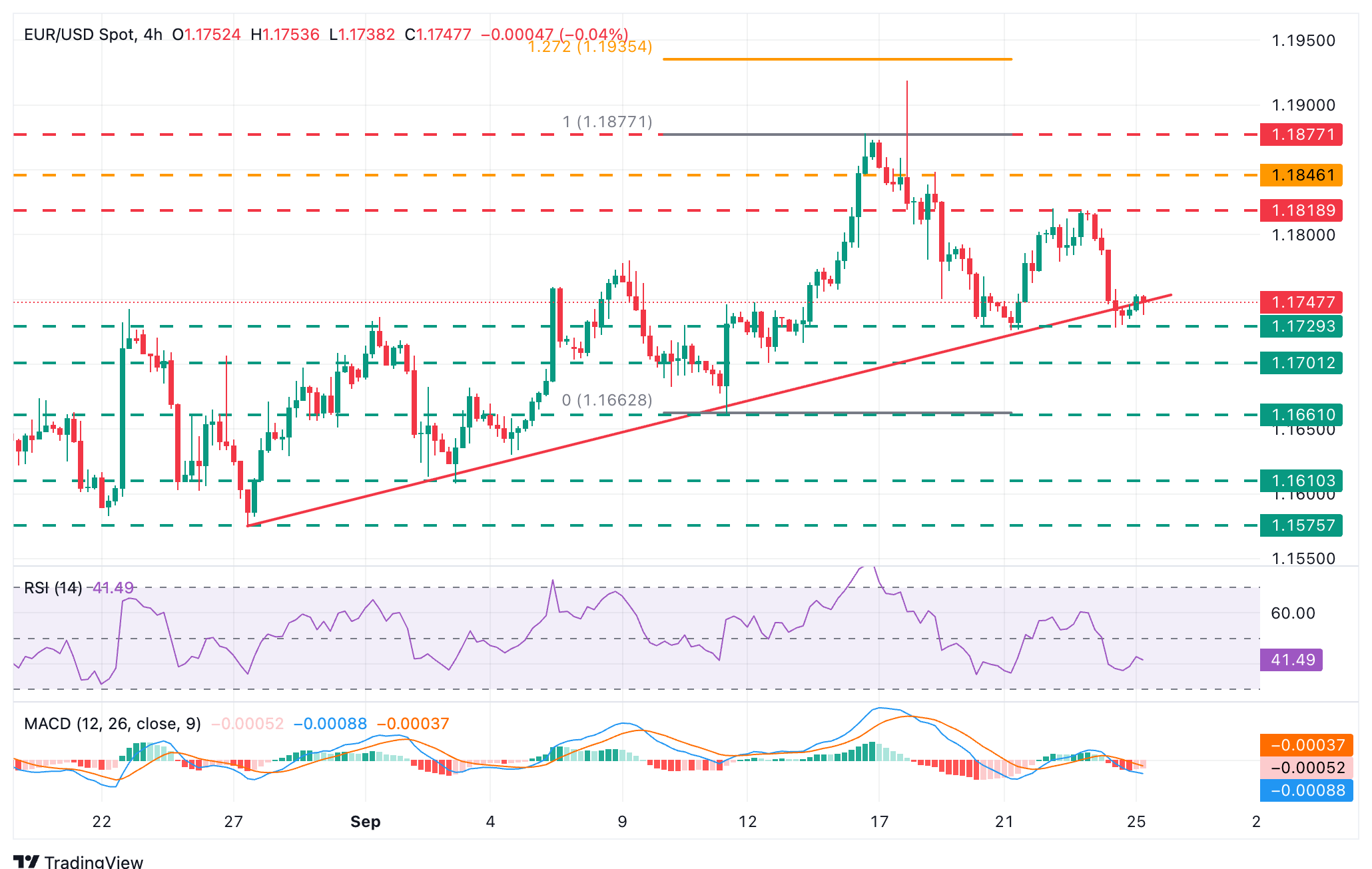Created
: 2025.09.25














![]() 2025.09.25 16:24
2025.09.25 16:24
EUR/USD is trading near the 1.1740 area at the moment of writing on Thursday, after retreating from weekly highs above 1.1800 the previous day. Federal Reserve (Fed) speakers have provided some support to the US Dollar (USD), showing a cautious tone on further interest rate cuts, while in Europe, recent macroeconomic figures have failed to cheer investors.
San Francisco Fed President Mary Daly showed openness to ease monetary policy, but she also highlighted the need to balance both central bank goals, employment and inflation, which casts some doubt on the timing of the next rate cut.
These comments align with the principles of Fed Chairman Jerome Powell's speech on Tuesday. He showed concern about inflation and affirmed that the bank will proceed slowly with interest rate cuts, contradicting the steep monetary easing cycle foreseen by the market's consensus.
In Europe, recent economic data have not been particularly supportive. The German IFO Business Climate Index deteriorated against expectations, and the preliminary PMIs showed mixed figures. The focus on Thursday will be on the final reading of US Q2 Gross Domestic Product (GDP) and several speeches by some Fed officials, although the highlight of the week is Friday's US Personal Consumption Expenditures (PCE) Price Index data, the Fed's favorite inflation gauge.
The table below shows the percentage change of Euro (EUR) against listed major currencies today. Euro was the strongest against the US Dollar.
| USD | EUR | GBP | JPY | CAD | AUD | NZD | CHF | |
|---|---|---|---|---|---|---|---|---|
| USD | -0.03% | -0.05% | -0.07% | -0.01% | -0.18% | -0.11% | -0.00% | |
| EUR | 0.03% | -0.03% | -0.05% | 0.00% | -0.13% | -0.09% | 0.02% | |
| GBP | 0.05% | 0.03% | 0.00% | 0.04% | -0.13% | -0.03% | 0.09% | |
| JPY | 0.07% | 0.05% | 0.00% | 0.03% | -0.14% | 0.12% | 0.08% | |
| CAD | 0.00% | -0.00% | -0.04% | -0.03% | -0.14% | -0.10% | 0.05% | |
| AUD | 0.18% | 0.13% | 0.13% | 0.14% | 0.14% | 0.36% | 0.17% | |
| NZD | 0.11% | 0.09% | 0.03% | -0.12% | 0.10% | -0.36% | -0.14% | |
| CHF | 0.00% | -0.02% | -0.09% | -0.08% | -0.05% | -0.17% | 0.14% |
The heat map shows percentage changes of major currencies against each other. The base currency is picked from the left column, while the quote currency is picked from the top row. For example, if you pick the Euro from the left column and move along the horizontal line to the US Dollar, the percentage change displayed in the box will represent EUR (base)/USD (quote).

EUR/USD came under strong bearish pressure on Wednesday and reversed the previous two days' gains to breach the trendline support from September 2 lows, now around 1.1750. Momentum indicators on the 4-hour chart are well into negative territory, and Tuesday's lower high strengthens the case for a trend shift.
Immediate support is now at the 1.1730 area (September 22 lows). Further down, the September 12 low, near 1.1700, and the September 11 low, at 1.1660, will come into focus. To the upside, the reverse trendline is acting now as resistance at the 1.1750 area. Above here, the targets are the September 23 high and the September 18 high, near 1.1850.
Monetary policy in the US is shaped by the Federal Reserve (Fed). The Fed has two mandates: to achieve price stability and foster full employment. Its primary tool to achieve these goals is by adjusting interest rates. When prices are rising too quickly and inflation is above the Fed's 2% target, it raises interest rates, increasing borrowing costs throughout the economy. This results in a stronger US Dollar (USD) as it makes the US a more attractive place for international investors to park their money. When inflation falls below 2% or the Unemployment Rate is too high, the Fed may lower interest rates to encourage borrowing, which weighs on the Greenback.
The Federal Reserve (Fed) holds eight policy meetings a year, where the Federal Open Market Committee (FOMC) assesses economic conditions and makes monetary policy decisions. The FOMC is attended by twelve Fed officials - the seven members of the Board of Governors, the president of the Federal Reserve Bank of New York, and four of the remaining eleven regional Reserve Bank presidents, who serve one-year terms on a rotating basis.
In extreme situations, the Federal Reserve may resort to a policy named Quantitative Easing (QE). QE is the process by which the Fed substantially increases the flow of credit in a stuck financial system. It is a non-standard policy measure used during crises or when inflation is extremely low. It was the Fed's weapon of choice during the Great Financial Crisis in 2008. It involves the Fed printing more Dollars and using them to buy high grade bonds from financial institutions. QE usually weakens the US Dollar.
Quantitative tightening (QT) is the reverse process of QE, whereby the Federal Reserve stops buying bonds from financial institutions and does not reinvest the principal from the bonds it holds maturing, to purchase new bonds. It is usually positive for the value of the US Dollar.
![]()
Created
: 2025.09.25
![]()
Last updated
: 2025.09.25

FXStreet is a forex information website, delivering market analysis and news articles 24/7.
It features a number of articles contributed by well-known analysts, in addition to the ones by its editorial team.
Founded in 2000 by Francesc Riverola, a Spanish economist, it has grown to become a world-renowned information website.
We hope you find this article useful. Any comments or suggestions will be greatly appreciated.
We are also looking for writers with extensive experience in forex and crypto to join us.
please contact us at [email protected].
Disclaimer:
All information and content provided on this website is provided for informational purposes only and is not intended to solicit any investment. Although all efforts are made in order to ensure that the information is correct, no guarantee is provided for the accuracy of any content on this website. Any decision made shall be the responsibility of the investor and Myforex does not take any responsibility whatsoever regarding the use of any information provided herein.
The content provided on this website belongs to Myforex and, where stated, the relevant licensors. All rights are reserved by Myforex and the relevant licensors, and no content of this website, whether in full or in part, shall be copied or displayed elsewhere without the explicit written permission of the relevant copyright holder. If you wish to use any part of the content provided on this website, please ensure that you contact Myforex.
Myforex uses cookies to improve the convenience and functionality of this website. This website may include cookies not only by us but also by third parties (advertisers, log analysts, etc.) for the purpose of tracking the activities of users. Cookie policy